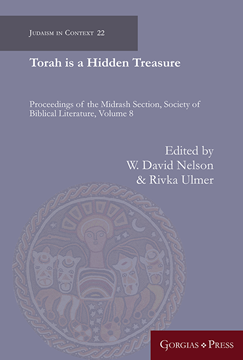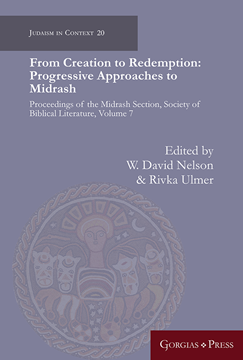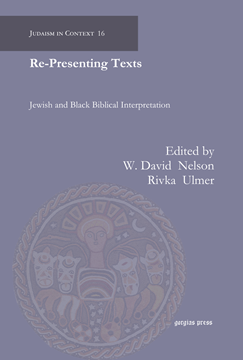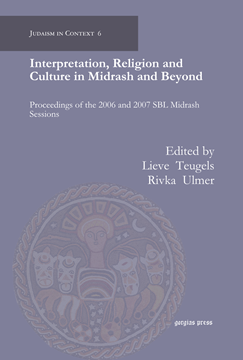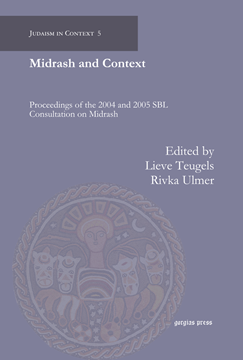Rivka Ulmer

Rivka Ulmer is Professor of Jewish Studies in the Department of Religious Studies at Bucknell University. Together with W. David Nelson, she serves as chair of the Midrash Section for the Society of Biblical Literature, and both have published widely in the interdisciplinary area of Jewish Studies, particularly in the field of Midrash.
Ten Measures of Beauty
Proceedings of the Midrash Section, Society of Biblical Literature
Edited by W. David Nelson & Rivka Ulmer
Series: Judaism in Context 34
ISBN: 978-1-4632-4800-0
The contributions that comprise Ten Measures of Beauty, the 10th volume published by the Society of Biblical Literature’s Midrash Section, pertain to Sifra, Midrash Tadshe and Masora, Rabbi Meyuḥas ben Elijah (a biblical commentator), food and meals in midrash, and peace studies.
$114.95 (USD) $68.97 (USD)
Emerging Horizons. 21st Century Approaches to the Study of Midrash
Proceedings of the Midrash Section, Society of Biblical Literature, volume 9
Edited by W. David Nelson & Rivka Ulmer
Series: Judaism in Context 26
ISBN: 978-1-4632-4365-4
The chapters in Emerging Horizons: 21st Century Approaches to the Study of Midrash pertain to an intriguing midrash that appears in a Masoretic context, the Qur’anic narrative of the red cow, midrashic narratives that rabbinize enemies of Israel, the death of Moses, emotions in rabbinic literature, and yelammedenu units in midrashic works.
$114.95 (USD) $68.97 (USD)
Torah is a Hidden Treasure
Proceedings of the Midrash Section, Society of Biblical Literature
Edited by W. David Nelson & Rivka Ulmer
Series: Judaism in Context 22
ISBN: 978-1-4632-4078-3
The chapters in Torah is a Hidden Treasure pertain to authorship in Seder Eliyahu Rabba and Pirqe deRabi Eliezer, natural law and Israel’s statutes, Masorah and midrash, as well as a definition of midrash. The Hebrew Bible and midrash is researched in the interpretation of Israelite tribes, the Ten Commandments and the Covenant Code, and in Rashbam’s Bible commentary and its exegetical devices.
$128.00 (USD) $76.80 (USD)
Progressive Approaches to Midrash
Proceedings of the Midrash Section, Society of Biblical Literature, Volume 7
Edited by W. David Nelson & Rivka Ulmer
Series: Judaism in Context 20
ISBN: 978-1-4632-0736-6
This volume contains selected proceedings of the Midrash Section sessions convened during the 2015-2016 meetings of the Society of Biblical Literature. It is comprised of contributions by both leading and emerging scholars of Midrash whose research shares a common focus on early and medieval rabbinic biblical interpretation. Additionally, the research on Midrash in this volume intersects with a range of related biblical texts, religious themes, and foundational and forward-thinking methodologies and interdisciplinary academic fields of study, including: Gender Studies; Classics; Jewish Studies; Religious Studies; Literary Studies; the Aqedah/Binding of Isaac; biblical parables; and, medieval rabbinic biblical commentary.
$127.00 (USD) $76.20 (USD)
"It’s better to hear the rebuke of the wise than the song of fools" (Qoh 7:5)
Proceedings of the Midrash Section, Society of Biblical Literature, Volume 6
Edited by W. David Nelson & Rivka Ulmer
Series: Judaism in Context 18
ISBN: 978-1-4632-0560-7
This volume contains selected proceedings of the Midrash Section sessions convened during the 2012-2014 meetings of the Society of Biblical Literature. It is comprised of contributions by leading and emerging scholars that share a common focus on Rabbinic biblical interpretation as it intersects with a range of biblical texts and associated fields of study, including: Jewish legal literature; Hellenistic Judaism; post-biblical interpretation; biblical commentary; liturgical studies; and, cultural studies.
$169.00 (USD) $101.40 (USD)
Righteous Giving to the Poor
Tzedakah ("Charity") in Classical Rabbinic Judaism, Including a Brief Introduction to Rabbinic Literature
By Rivka Ulmer & Moshe Ulmer
Series: Gorgias Handbooks 29
ISBN: 978-1-4632-0261-3
Moral insights and comments about Tzedakah ("Charity") are found throughout the vast body of rabbinic literature. This book attempts to present a survey of the rabbinic sources concerning Tzedakah and to provide the reader with an analysis of the system of Tzedakah as created and understood by the Rabbis.
$55.00 (USD) $33.00 (USD)
Re-Presenting Texts
Jewish and Black Biblical Interpretation
Edited by W. David Nelson & Rivka Ulmer
Series: Judaism in Context 16
ISBN: 978-1-61143-924-3
This is the fifth issue of Proceedings of the Midrash Section at the Annual Meeting of the Society of Biblical Literature published in this series, and contains six papers on Jewish and Black biblical hermeneutics with regard to Rabbinic Midrash.
$159.00 (USD) $95.40 (USD)
Midrash and the Exegetical Mind
Proceedings of the 2008 and 2009 SBL Midrash Sessions
Edited by Lieve M. Teugels & Rivka Ulmer
Series: Judaism in Context 10
ISBN: 978-1-61143-683-9
Contained in this volume are the Proceedings of the Midrash session of the SBL's annual conferences in 2008 and 2009. This volume contains eight essays dealing with various aspects of rabbinic interpretation.
$172.00 (USD) $103.20 (USD)
Interpretation, Religion and Culture in Midrash and Beyond
Proceedings of the 2006 and 2007 SBL Midrash Sessions
Edited by Lieve M. Teugels & Rivka Ulmer
Series: Judaism in Context 6
ISBN: 978-1-59333-619-6
The third issue of Proceedings of the Midrash session at the SBL Annual meeting published in this series. This volume contains papers on religion in midrash (2006) and modes of biblical interpretation in rabbinic, Syriac and Islamic traditions (2007).
$161.00 (USD) $96.60 (USD)
Midrash and Context
Proceedings of the 2004 and 2005 SBL Consultation on Midrash
Edited by Lieve M. Teugels & Rivka Ulmer
Series: Judaism in Context 5
ISBN: 978-1-59333-582-3
A collection of seven groundbreaking essays on Rabbinic midrash and related texts by a new generation of erudite scholars combining the themes of the 2004 and 2005 SBL midrash sessions: “Jewish and Christian Hermeneutics” and “Midrash and Cultural Studies,” this book is a must have for clergy, students, scholars, and laypersons interested in deepening their understanding of Rabbinic and Patristic biblical interpretation.
$167.00 (USD) $100.20 (USD)
Recent Developments in Midrash Research
Proceedings of the 2002 and 2003 SBL Consultation on Midrash
Edited by Lieve M. Teugels & Rivka Ulmer
Series: Judaism in Context 2
ISBN: 1-59333-201-7
This work consists of a selection of papers from sessions during the first two years of SBL Consultation on Midrash. It demonstrates innovative approaches to midrashic texts and hermeneutic reflections on similarities and differences between interpretations of the Bible.
$111.00 (USD) $66.60 (USD)



